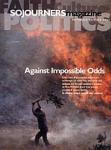This spring a group of "troubled" children from Washington, D.C.'s Evans Middle School were taken on a visit to the D.C. Jail. The school's director of in-service suspension, who arranged the jail visit, said, "I wanted some of the kids to experience the jail-you know, the clink-clink, the bars." The visiting students-some as young as 13-were intimidated by guards, strip-searched, forced to undergo a body-cavity search, and left in the presence of a masturbating inmate-all so they would be "scared straight."
The Scared Straight program-founded in 1976 at New Jersey's Rahway State Prison-remains one of the most popular "intervention" methods for dealing with troubled teens. But does it work?
A 1979 documentary on the program, which depicted tough teens being reduced to quivering masses by big, scary inmates, won an Academy Award and two Emmys. The producers of the show claimed an 80 to 90 percent success rate, and the race to bring Scared Straight to a city near you was on. Legislators around the country couldn't wait to implement such programs to eradicate the scourge of juvenile delinquency. The concept continues to thrive around the country.
But many studies have belied the success claims of Scared Straight. "Youths attending the programs consistently did worse than those who did not," wrote James O. Finckenauer in his 1999 book Scared Straight: The Panacea Phenomenon Revisited. He's not alone in this assessment. According to Youth Violence: A Report of the Surgeon General released earlier this year, successful prevention programs "target specific populations of young people as defined by risk and life experience, build individual skills and competencies, include parent effectiveness training, and encourage changes in type and level of involvement in peer groups." Not exactly a description of the Scared Straight approach.
The surgeon general's report highlights 27 specific youth violence prevention programs that are effective at preventing youth violence and cost-effective as well. Scared Straight is identified in the report as "consistently ineffective" and is placed in the category "Does Not Work." In fact, studies cited in the report conclude that the program further "hardens troubled children and increases their involvement in crime and violence."
So why keep going with a method that has been found to be ineffective at best and harmful at worst? There is an increasing tendency in our society to criminalize children, to charge and try children as adults. The Scared Straight and boot camp-type programs seem to be preparing children for the prison industrial complex. And children know it, especially those in inner-city public schools.
Many young people-especially black males-start out with the heavy yoke of negative stereotypes. "By middle school they are labeled as special education, learning disabled, angry, etc.," says Una-Kariim Cross of LISTEN, Inc., a youth leadership-development organization, "and with the teacher-to-student ratio being what it is, they become marginalized."
"There are serious long-term effects of being labeled a Troublemaker that substantially increases one's chances of ending up in jail," explains Ann A. Ferguson in Bad Boys: Public Schools in the Making of Black Masculinity. "Time in the school dungeon means time lost from classroom learning; suspension, at school or at home, has a direct and lasting negative effect on the continuing growth of a child." Many of these black boys-either consciously or subconsciously-view school as a component of the "prison conditioning process."
In New York City the politicians have hastened the process. For the last three years the police department has been in control of security in the public schools. Considering NYPD's well-documented tactics of harassment and abuse against people of color, many feel that the schools have become conditioning centers for incarceration, including lock-downs, stop and frisks, and holding cells. One student told the Village Voice, "The [police] are like recruiters around here, only they don't want us for the NBA or the NFL. They want us for jail."
In the 25 years since Scared Straight was born, more than 1,000 prisons and jails have been built in the United States, yet the prisons are more crowded than ever. It's obvious that scaring kids straight isn't working. If we want real results, perhaps we ought to try loving them straight instead.
Larry Bellinger is an assistant editor of Sojourners.

Got something to say about what you're reading? We value your feedback!